wheel size AUDI RS7 SPORTBACK 2015 Owners Manual
[x] Cancel search | Manufacturer: AUDI, Model Year: 2015, Model line: RS7 SPORTBACK, Model: AUDI RS7 SPORTBACK 2015Pages: 302, PDF Size: 74.76 MB
Page 147 of 302
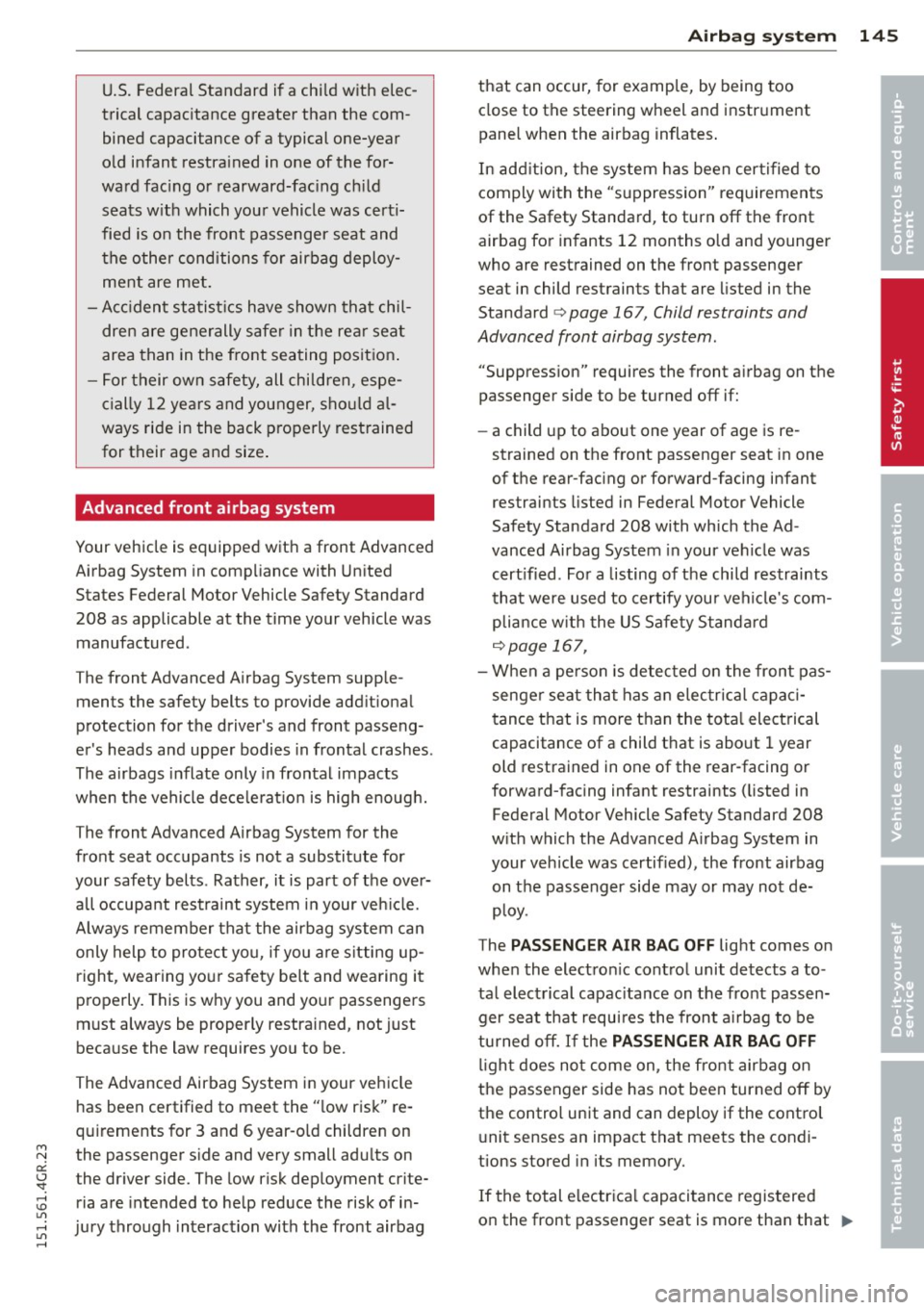
M N
0:: <.J 'SI: ,...., \!) ..,.,
,...., ..,., ,....,
U.S. Federal Standard if a child with elec
trical capac itance greater than the com
bined capacitance of a typical one-year
old infant restra ined in one of the for
ward fac ing or rearward-fac ing ch ild
seats w ith which your vehicle was certi
fied is on the front passenger seat and
the other conditions for airbag deploy ment are met.
- Acc ident statist ics have shown that chil
dren are generally safer in the rea r seat
area than in the front seating posit ion .
- For their own safety, all children, espe
c ially 12 years and younger, sho uld al
ways ride in the back p roperly rest rained
for their age an d size .
Advanced front airbag system
Your veh icle is equipped w ith a front Advanced
Airbag System in comp liance with Un ited
States Federal Motor Vehicle Safety Standard 208 as applicable at the time your vehicle was
manufactured.
The front Advanced Airbag System supple ments the safety belts to provide add it iona l
protection for the driver's and front passeng
e r's heads and upper bodies in frontal crashes.
The airbags inflate only in frontal impacts
when the vehicle dece le rat io n is high enough.
The front Advanced A irbag System for the
fro nt seat occupants is not a substitute for
your safety belts . Rather, it is part of the over
all occupant rest raint system in your ve hicle.
A lways remember that the airbag system can
only help to pro tect you, if you are s itting up
righ t, wearing yo ur sa fety belt and wearing it
properly. This is why you and yo ur passengers
must always be properly restrained, not just
because the law requires you to be.
The Advanced Airbag System in your veh icle
h as been certified to meet the " low r isk" re
q uir ements for 3 and 6 year-o ld children on
the passenger s ide and very small adu lts on
the dr iver side. The low risk deployment crite
ria are intended to he lp reduce the risk of i n
j ury through interaction with the front airbag
A irbag system 145
that can occur, for examp le, by being too
close to the steering wheel and instr ument
panel when the airbag inflates .
In add ition, the system has been cert ified to
comply with the "s uppression" requirements
of the Safety Standard, to turn off the front
airbag for in fants 12 months o ld and younger
who are rest rained on the front passenger
seat in child restraints that are listed in the
Standa rd
c> page 167, Child restraints and
Advanced front airbag system .
"Suppression" requires the front a irbag on the
passenger side to be turned off if:
- a child up to abo ut one year of age is re
strained on the front passenger seat in one
of the rear-fac ing or forward -facing infant
restraints listed in Federal Motor Vehicle
Safety Standard 208 with which the Ad
vanced Airbag System in your ve hicle was
cert ified . Fo r a listing of the chi ld restraints
that were used to certify you r vehicle's com
p lia nce w it h t he US Safe ty Stand ard
c>page 167,
-When a pe rson is detec ted o n the front pas
senge r seat that has an e lec trica l capa ci
tance t hat is more than the tota l elect rical
capacitance of a child that is about 1 year
old restrained in one of the rear-facing or
forward-facing infant restraints (listed in Federal Motor Vehicle Safety Standard 208
w ith which the Advanced A irbag System in
your vehicle was certified), the front airbag
on t he passenger side may or may not de
ploy.
The
PASSENG ER AIR BAG OFF light comes on
when the electron ic cont ro l unit de tects a to
ta l elect rical capac itance on the front passen
ger seat that requi res the front a irbag to be
turned off. If the
PASSENGER AIR BAG OFF
li gh t does no t come on, the front airbag on
the passenger side has not been turned off by
the contro l unit and can deploy if the control
u nit senses an impact that meets the condi
tions stored in its memory.
If the total e lectr ica l capacitance registered
on the front passenger seat is more than that
ll>
•
•
Page 190 of 302
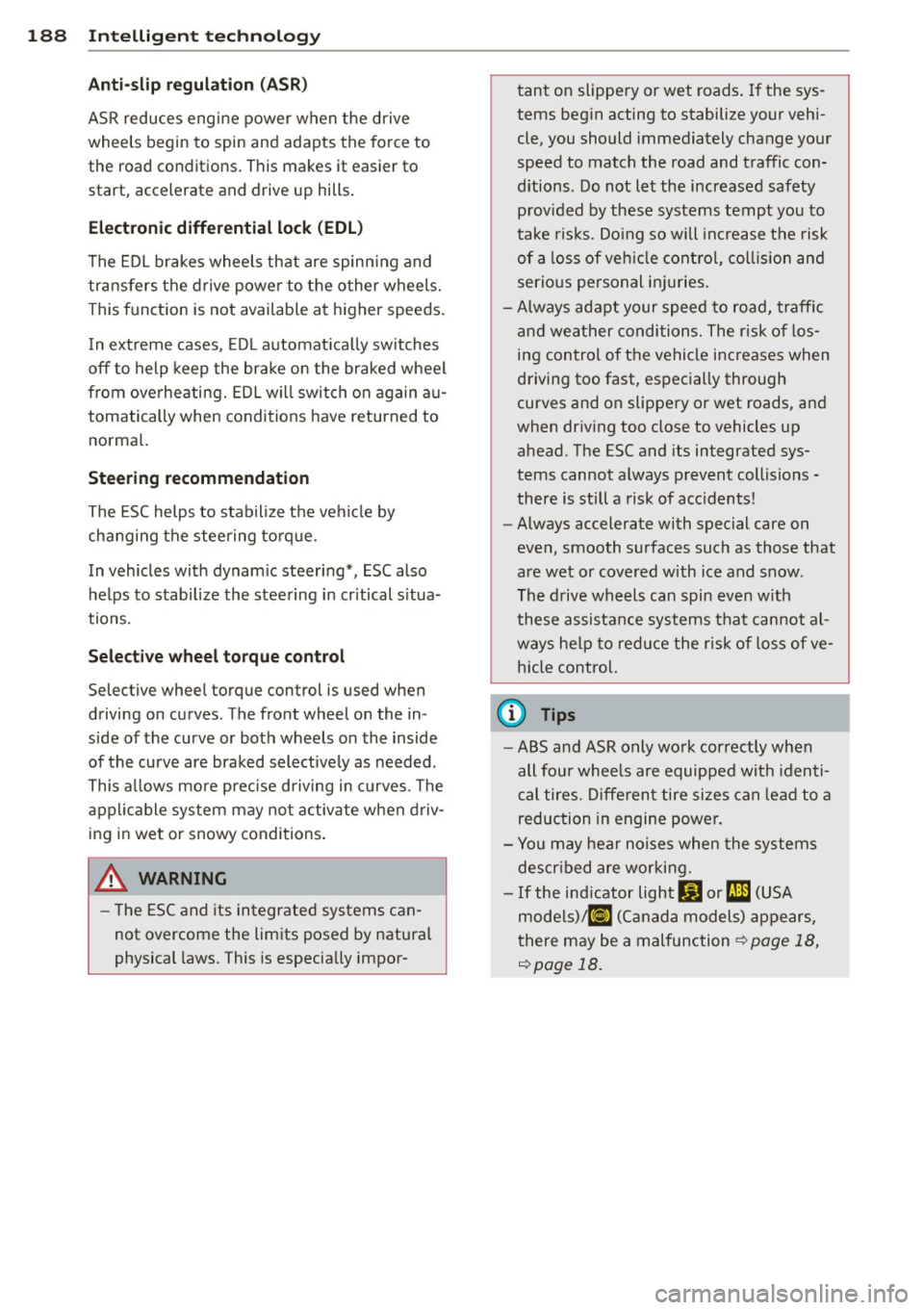
188 Intelligent technology
Anti-slip regulation (ASR )
ASR reduces engine power when the drive
wheels begin to spin and adapts the force to
the road conditions. This makes it easier to
start, accelerat e and drive up hills .
Electronic differential lock (EDL )
The ED L brakes wheels that are spinn ing and
transfers the drive powe r to the o ther wheels.
This function is not availab le at higher speeds.
I n extreme cases , ED L automat ica lly switches
off to help keep the brake on the braked whee l
from ove rheating. EDL wi ll sw itch on aga in au
tomatically when conditions have returned to
norma l.
Steering recommendation
The ESC helps to stabilize the ve hicle by
changing the steering to rque.
In vehicles with dynam ic steering*, ESC also
he lps to stabilize the stee ring in critical s itua
tions.
Selective wheel torque control
Selective wheel torque control is used when
driving on curves . The front wheel on the in
side of the curve o r both wheels on the inside
of the curve are braked selective ly as needed.
This a llows more prec ise driving in curves. The
appl icable system may no t activ ate when driv
ing in wet or snowy condi tions .
A WARNING
- The ESC and its integrated systems can
not overcome the lim its posed by natural
physical laws. This is especia lly impor- tant on slippery or wet roads
. If the sys
tems beg in acting to stabilize your vehi
cle, you should immediately change your
speed to match the road and traffic con
ditions . Do not let the increased safety
provided by these systems tempt you to
take risks. Do ing so will increase the risk
of a loss of veh icle contro l, collision and
serio us pe rsonal inj uries.
- Always ad apt your speed to road, traffic
a nd wea ther conditions. The risk of los
ing con trol of the vehicle increases when
driving too fast, especially through
curves and on slippe ry or wet roads, and
when dr iv ing too close to vehicles up
ahead . The ESC and its integrated sys
tems cannot a lways prevent collisions -
there is still a risk of acc idents!
- Always accelerate with special care on
even, smooth su rfaces such as those that
are wet or covered with ice and snow.
The drive wheels can spin even w ith
these assistan ce sys tems that cannot al
ways he lp to re duce the risk of loss of ve
h icle control.
(D Tips
- ABS and ASR o nly wo rk correctly when
all four wheel s are equipped with identi
c al tires . D iffe ren t tire sizes can lead to a
reduction in engine power.
- Yo u may hear noises when the systems
descr ibed are working.
- If the ind icator lig ht
BJ or rJlll (USA
mode ls)/ l§J (Can ada models) appears,
t here may be a malfunction ¢
page 18,
r:!>page 18.
Page 195 of 302
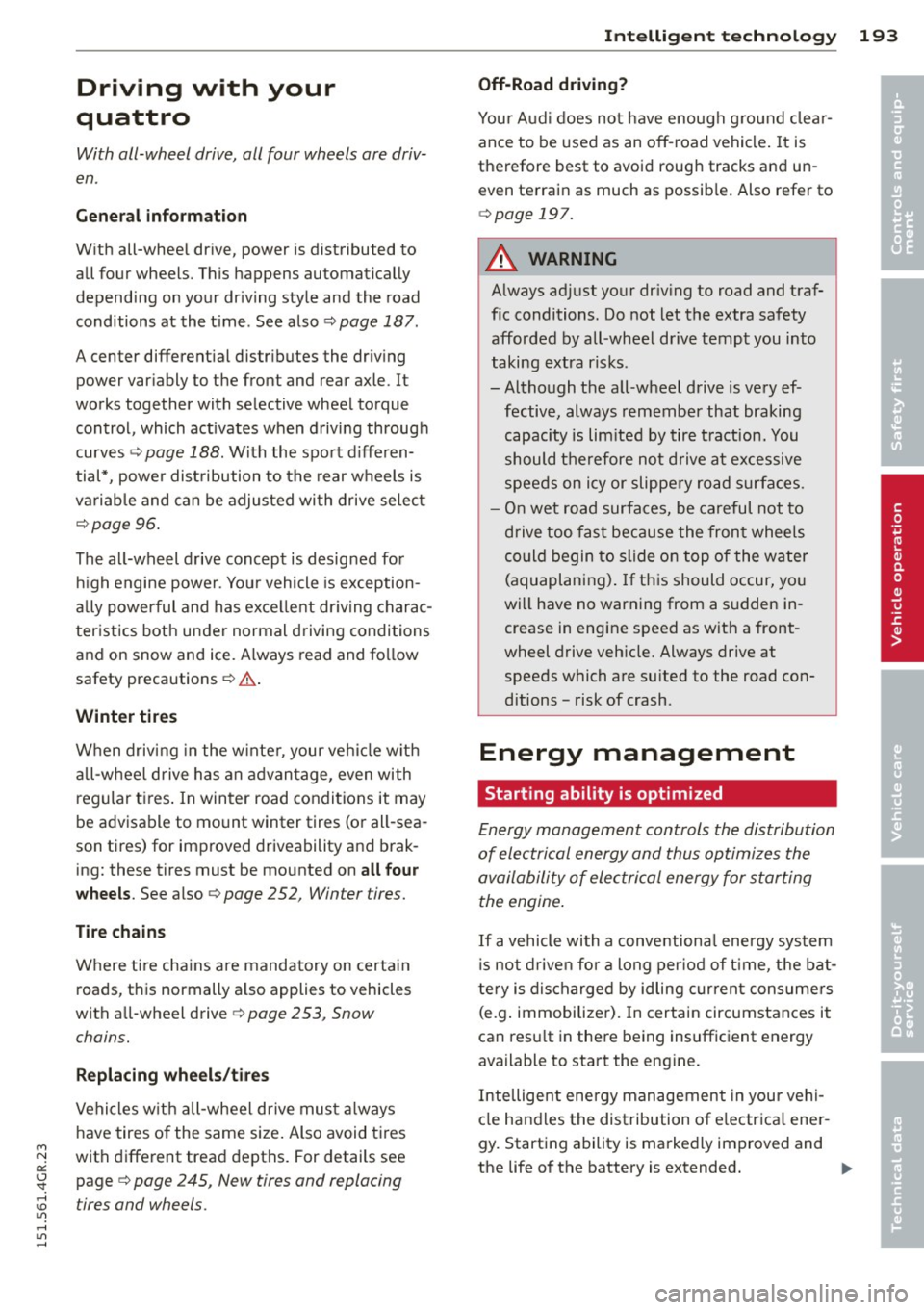
M N
0:: <.J 'SI:
Driving with your
quattro
With all-wheel drive, all four wheels are driv
en .
General information
With all-wheel drive, power is distributed to
all four wheels . This happens automatically
depending on your driving style and the road
conditions at the time . See also ¢
page 187.
A center differential distributes the driving
power variably to the front and rear axle. It
works together with selective wheel torque
control, which activates when driving through
curves ¢
page 188 . With the sport d ifferen
tial*, power distribution to the rear wheels is
va riable and can be adjusted with drive select
¢page 96.
The all-wheel drive concept is designed for
hi gh engine power. Your vehicle is exception
ally powerful and has exce llent dr iving charac
teristics both under normal driving conditions
and on snow and
ice. Always read and follow
safety precautions ¢.& .
Winter tires
When driving in the w inter , your ve hicle with
all-wheel drive has an advantage, even with
regular tires. In winter road conditions it may
be advisable to mount winter tires (or all-sea
son t ires) for improved driveability and brak
ing: these tires must be mounted on
all four
wheels. See also ¢ page 252, Winter tires.
Tire chains
Where tire chains are mandatory on certain
roads, this normally a lso applies to vehicles
with a ll-wheel drive¢
page 253, Snow
chains.
Replacing wheels/tires
Vehicles w ith all-wheel drive must always
have tires of the same size. Also avoid tires
with different tread depths. For details see
page ¢
page 245, New tires and replacing
~ tires and wheels . 1.1'1 ,...., 1.1'1 ,....,
Intelligent technology 193
Off•Road driving?
Your Audi does not have enough g round clear
ance to be used as an off-road vehicle.
It is
therefore best to avoid rough tracks and un
even terrain as much as possible. Also refer to
¢page 197.
A WARNING
Always adjust your dr iv ing to road and traf
fic conditions. Do not let the extra safety
afforded by all-wheel drive tempt you into
taking extra risks.
- Although the all-wheel drive is very ef fective, always remember that braking
capacity is lim ited by tire traction. You
should therefore not drive at excessive
speeds on icy or slippery road surfaces.
- On wet road surfaces, be careful not to
drive too fast because the front wheels
could begin to slide on top of the water
(aquaplaning) . If this should occur, you
will have no warning from a sudden in
crease in engine speed as with a front
wheel drive veh icle. Always drive at
speeds which are su ited to the road con
ditions - risk of crash.
Energy management
Starting ability is optimized
Energy management controls the distribution
of electrical energy and thus optimizes the
availability of electrical energy for starting
the engine .
If a vehicle with a conventiona l energy system
is not driven for a long period of tim e, the bat
tery is discharged by idling current consumers
(e.g . immobilizer). In certain circumstances it
can resu lt in there being insufficient energy
available to start the eng ine.
Intelligent energy management in your vehi
cle handles the distribution of e lectrica l ene r
gy. Starting ability is markedly improved and
the life of the battery is extended .
ll>
•
•
Page 231 of 302
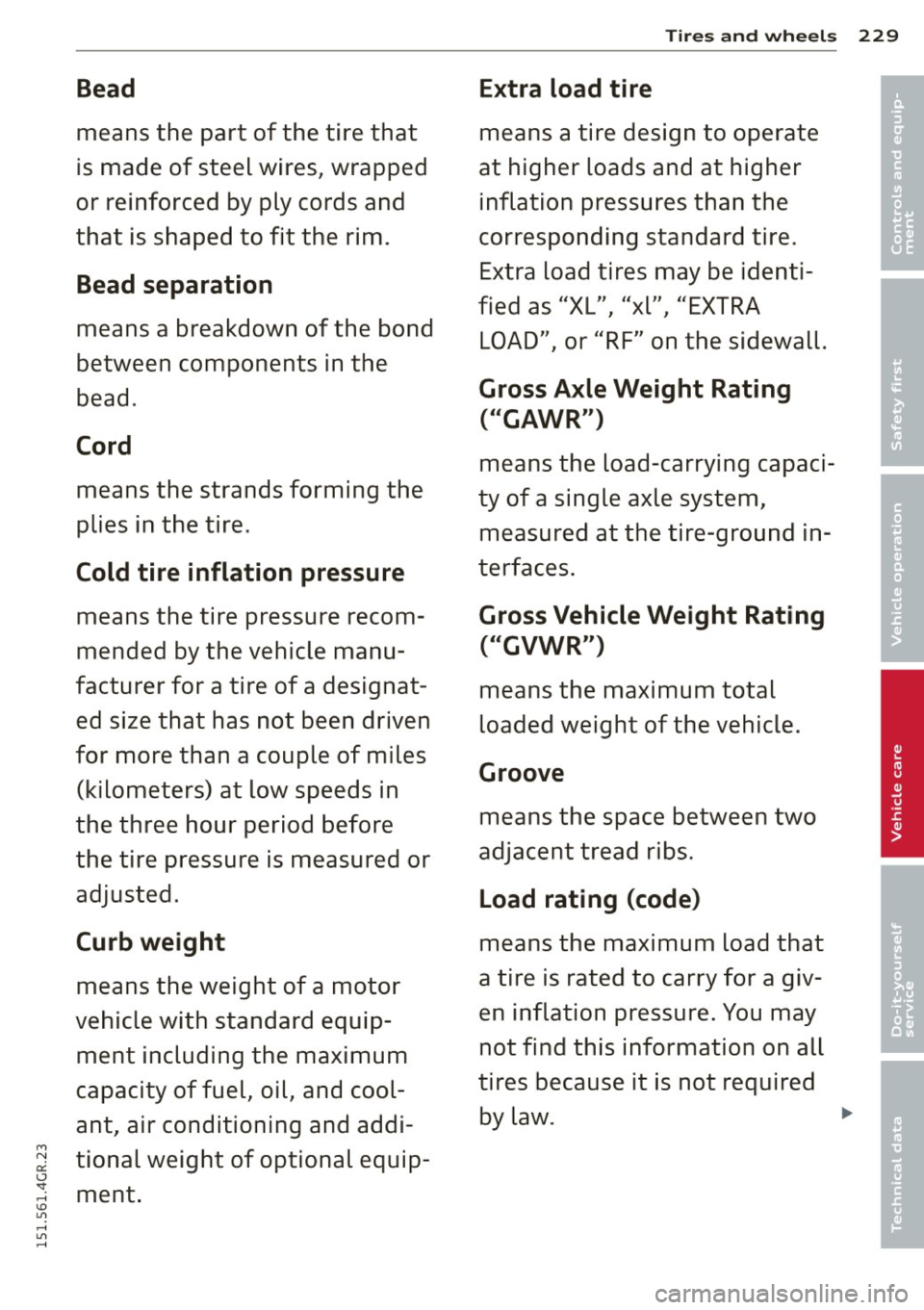
Bead
means the part of the tire that
is made of steel wires, wrapped
or reinforced by ply cords and
that is shaped to fit the rim .
Bead separation
means a breakdown of the bond
between components in the
bead.
Cord
means the strands forming the
plies in the tire.
Cold tire inflation pressure
means the tire pressure recom
mended by the vehicle manu
facturer for a tire of a designat
ed size that has not been driven
for more than a couple of miles (kilometers) at low speeds in
the three hour period before
the tire pressure is measured or
adjusted.
Curb weight
means the weight of a motor
vehicle with standard equip
ment including the maximum
capacity of fuel, oil, and cool
ant, air conditioning and addi
tional weight of optional equip
ment.
Tires and wheels 229
Extra load tire
means a tire design to operate
at higher loads and at higher inflation pressures than the
corresponding standard tire. Extra load tires may be identi
fied as "XL", "xl", "EXTRA
LOAD", or "RF" on the sidewall.
Gross Axle Weight Rating ("GAWR")
means the load-carrying capaci
ty of a single axle system,
measured at the tire-ground in
terfaces.
Gross Vehicle Weight Rating ("GVWR")
means the maximum total
loaded weight of the vehicle.
Groove
means the space between two
adjacent tread ribs.
Load rating (code)
means the maximum load that
a tire is rated to carry for a giv
en inflation pressure. You may
not find this information on all
tires because it is not required by law.
•
•
'
Page 233 of 302
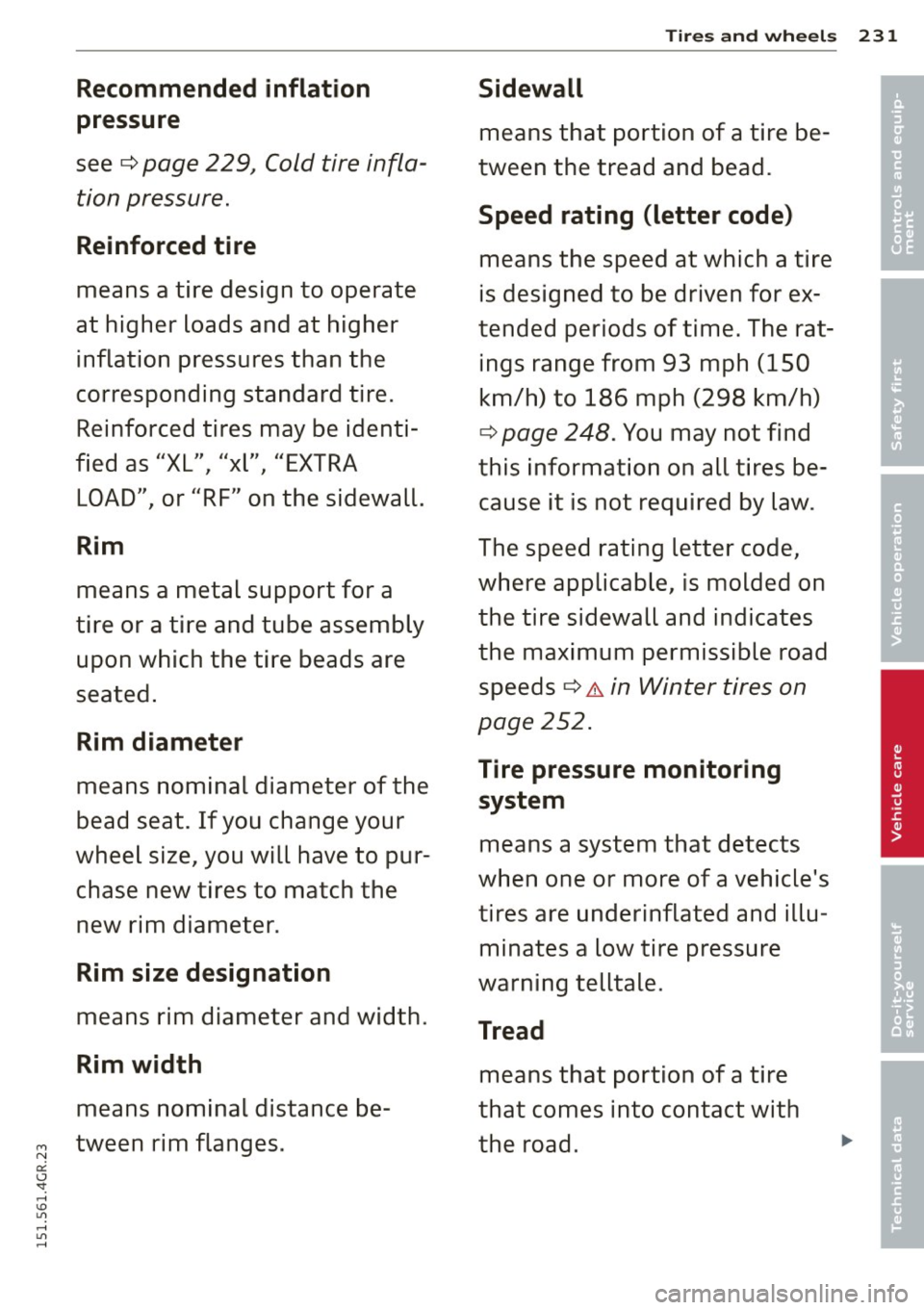
Recommended inflation
pressure
see¢ page 229J Cold tire infla
tion pressure.
Reinforced tire
means a tire design to operate
at higher loads and at higher
inflation pressures than the
corresponding standard tire. Reinforced tires may be identi
fied as "XL", "xl", "EXTRA
LOAD", or "RF" on the sidewall.
Rim
means a metal support for a
tire or a tire and tube assembly
upon which the tire beads are
seated.
Rim diameter
means nominal diameter of the
bead seat. If you change your
wheel size, you will have to pur chase new tires to match the
new rim diameter.
Rim size designation
means rim diameter and width.
Rim width
means nominal distance be
~ tween rim flanges.
0:: <.J 'SI: ,...., \!) 1.1'1 ,...., 1.1'1 ,....,
Tires and wheels 231
Sidewall
means that portion of a tire be
tween the tread and bead.
Speed rating (letter code)
means the speed at which a tire
is designed to be driven for ex
tended periods of time. The rat ings range from 93 mph (150
km/h) to 186 mph (298 km/h)
¢
page 248. You may not find
this information on all tires be cause it is not required by law.
The speed rating letter code,
where applicable, is molded on
the tire sidewall and indicates
the maximum permissible road speeds ¢
A in Winter tires on
page 252.
Tire pressure monitoring system
means a system that detects
when one or more of a vehicle's tires are underinflated and illu
minates a low tire pressure
warning telltale.
Tread
means that portion of a tire
that comes into contact with
the road.
•
•
'
Page 237 of 302
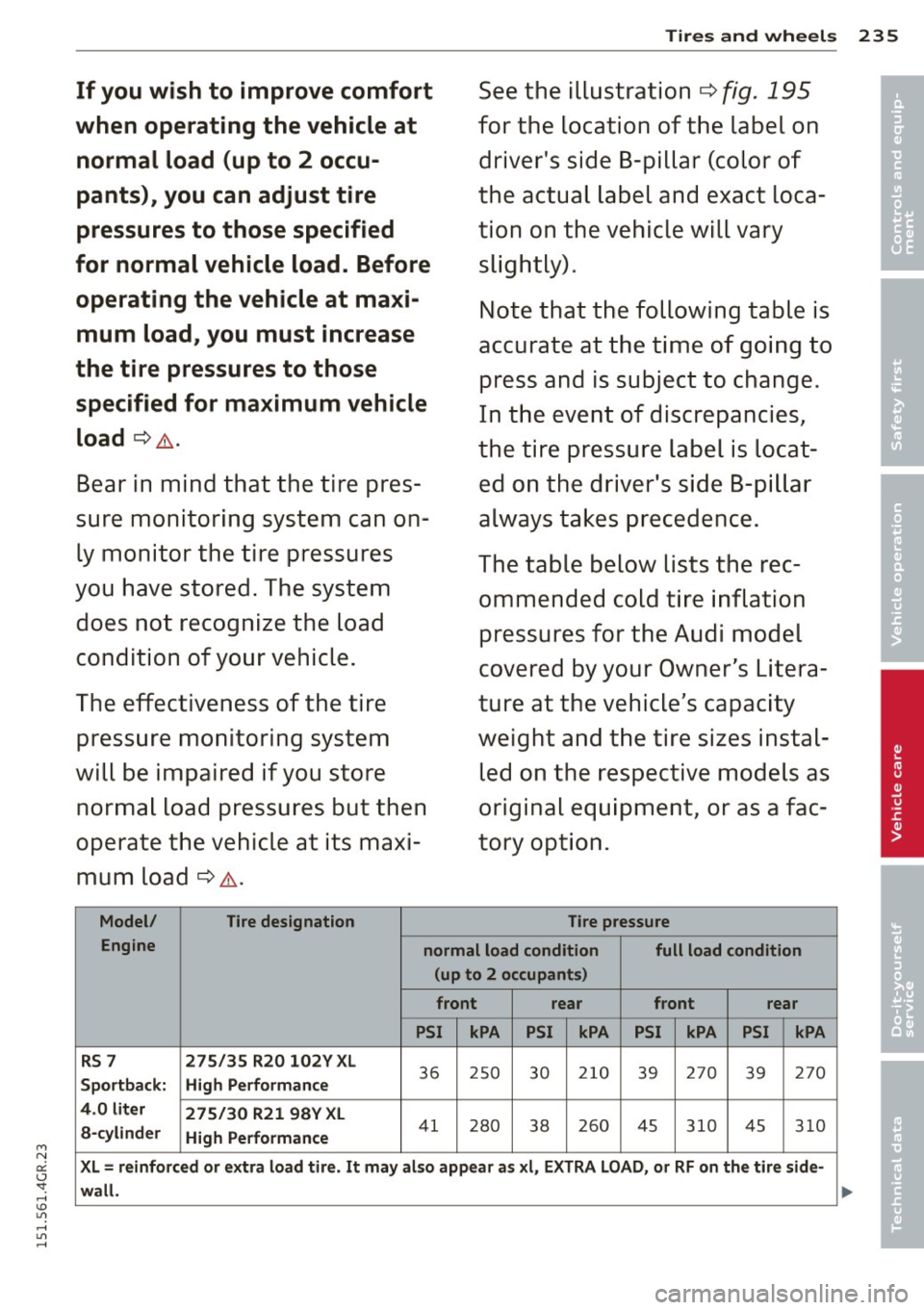
Tires and wheels 235
If you wish to improve comfort
when operating the vehicle at
normal load (up to 2 occu
pants), you can adjust tire
pressures to those specified
for normal vehicle load. Before
operating the vehicle at maxi mum load, you must increase
the tire pressures to those
specified for maximum vehicle
load
c> .&. .
Bear in mind that the tire pres
sure monitoring system can on
ly monitor the tire pressures
you have stored. The system does not recognize the load
condition of your vehicle.
The effectiveness of the tire p ressure monitoring system
will be impaired if you store normal load pressures but then
operate the vehicle at its maxi
mum load
c> .&. .
Model/ Tire designation
See the illustration c> fig. 195
for the location of the label on
driver's side B-pillar (color of
the actual label and exact loca
tion on the vehicle will vary slightly).
Note that the following table is
accurate at the time of going to
press and is subject to change.
In the event of discrepancies,
the tire pressure label is locat ed on the driver's side B-pillar
always takes precedence.
The table below lists the rec ommended cold tire inflation pressures for the Audi model
covered by your Owner's Litera
ture at the vehicle's capacity
weight and the tire sizes instal
led on the respective models as
original equipment , or as a fac
tory option.
Tire pressure
Engine normal load condition full load condition
(up to 2 occupants)
front rear front rear
PSI kPA PSI kPA PSI kPA PSI kPA
RS 7 275/35 R20 102V XL
3 6 250 30 210 39 270 39 270 Sportback: High Performance
4.0 liter 275/30 R21 98V XL
a -cylinder
High Performance
41 280 38 26
0 4 5 310 45 310
XL= reinforced or extra load tire. It may also appear as xl, EXTRA LOAD, or RF on the tire side-
wall.
•
•
'
Page 238 of 302
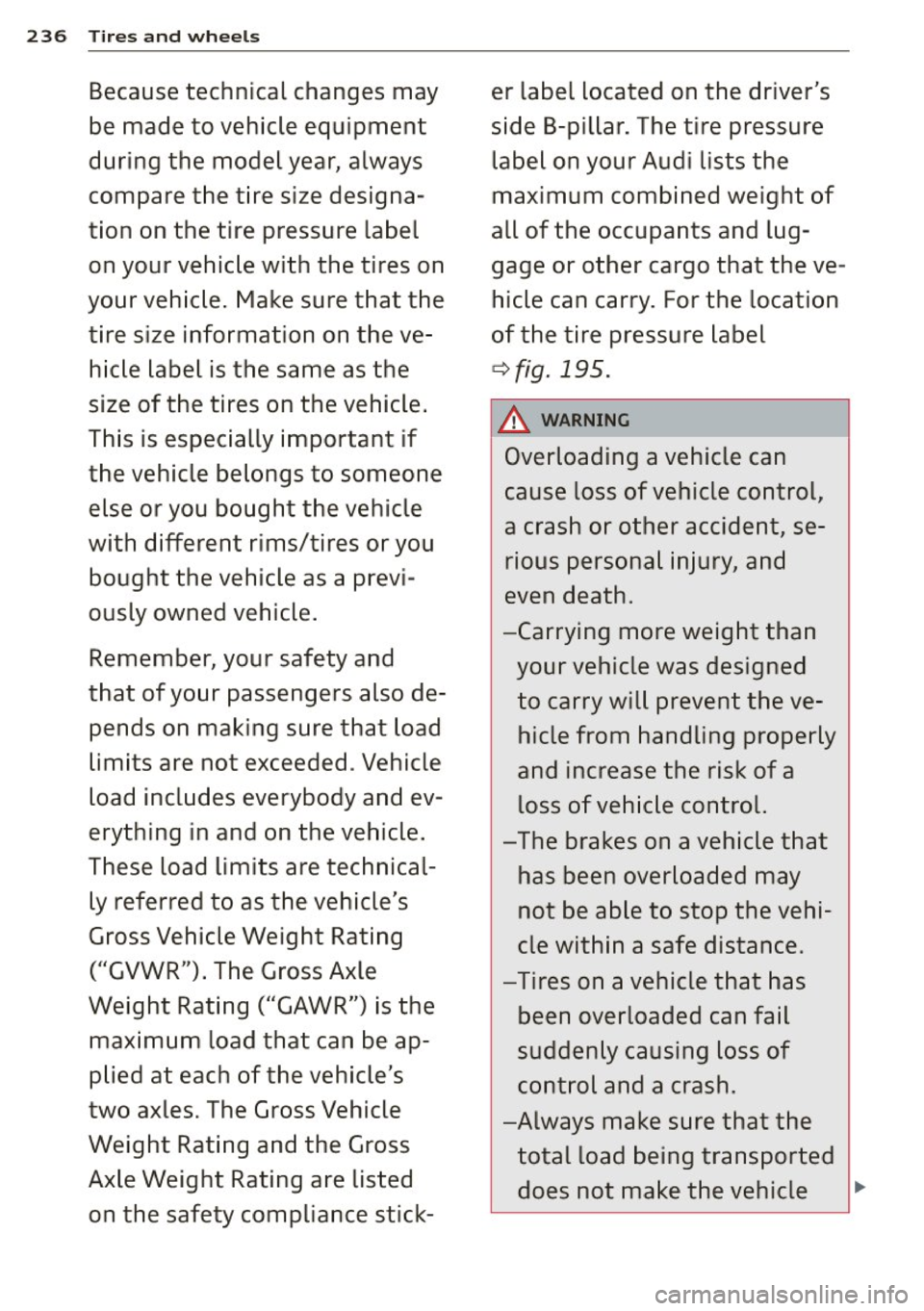
236 Tires and wheels
Because technical changes may
be made to vehicle equipment
during the model year, always
compare the tire size designa
tion on the tire pressure label
on your vehicle with the tires on
your vehicle . Make sure that the
tire size information on the ve hicle label is the same as the
size of the tires on the vehicle .
This is especially important if
the vehicle belongs to someone else or you bought the vehicle
with different rims/tires or you bought the vehicle as a previ
ously owned vehicle.
Remember, your safety and
that of your passengers also de pends on making sure that load
limits are not exceeded . Vehicle
load includes everybody and ev
erything in and on the vehicle .
These load limits are technical ly referred to as the vehicle's
Gross Vehicle Weight Rating
("GVWR"). The Gross Axle
Weight Rating ("GAWR") is the
maximum load that can be ap
plied at each of the vehicle's
two axles . The Gross Vehicle
Weight Rating and the Gross
Axle Weight Rating are listed on the safety compliance stick- er label located on the driver's
side B-pillar. The tire pressure
label on your Audi lists the
maximum combined weight of
all of the occupants and lug
gage or other cargo that the ve
hicle can carry. For the location
of the tire pressure label
¢ fig. 195.
&_ WARNING
-
Overloading a vehicle can
cause loss of vehicle control,
a crash or other accident, se
rious personal injury, and
even death .
- Carrying more weight than
your vehicle was designed to carry will prevent the ve
hicle from handling properly
and increase the risk of a
loss of vehicle control.
-The brakes on a vehicle that has been overloaded may
not be able to stop the vehi
cle within a safe distance.
- Tires on a vehicle that has
been overloaded can fail
suddenly causing loss of
control and a crash.
-Always make sure that the total load being transported
does not make the vehicle .,.
Page 246 of 302
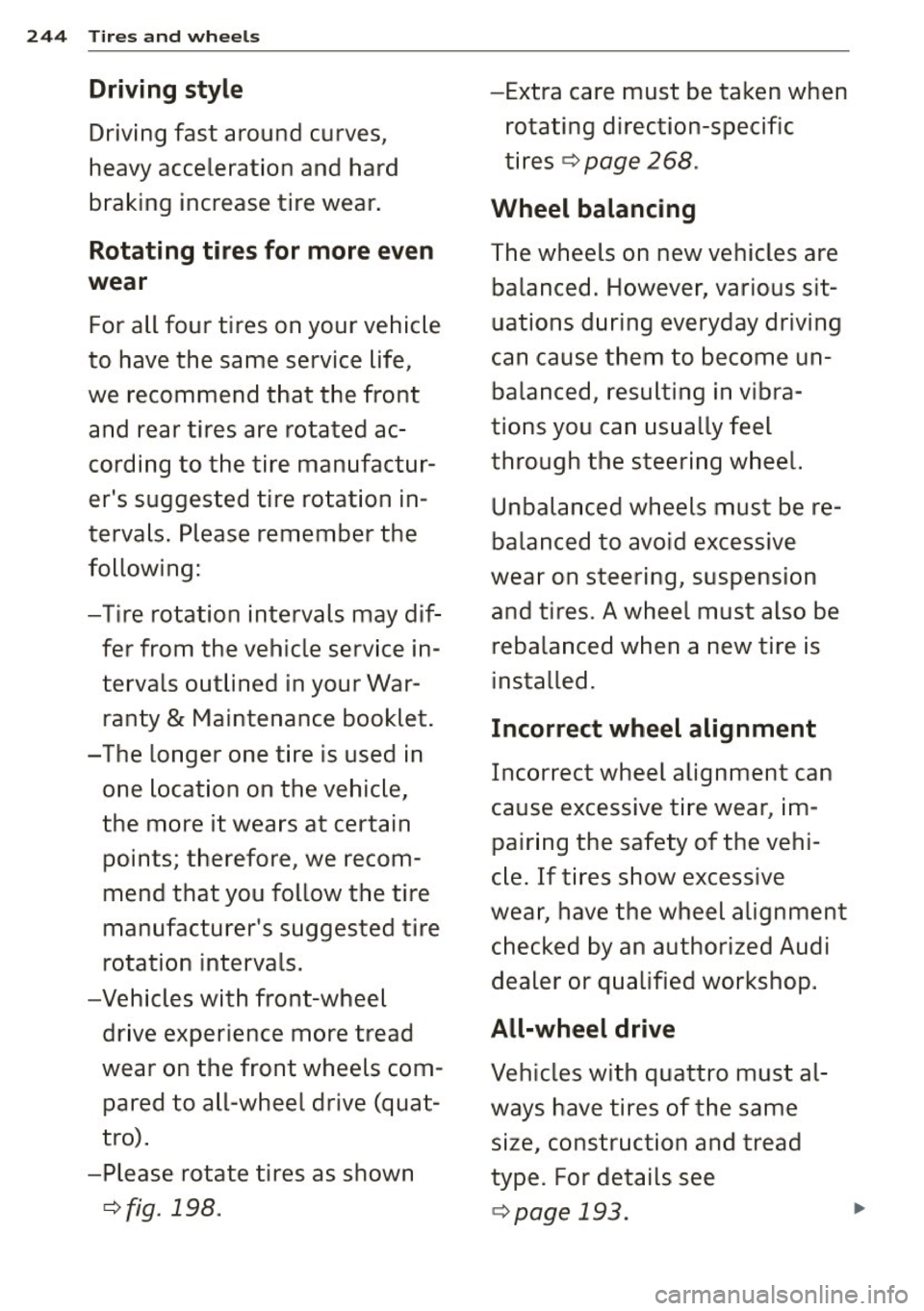
244 Tires and whee ls
Driving style -Extra care must be taken when
Driving fast around curves, rotating direction-specific
heavy acceleration and hard tires
¢
page 268.
braking increase tire wear. Wheel balancing
Rotating tires for more even
The wheels on new vehicles are
wear ba lanced. However, various sit-
For all four tires on your vehicle uations during everyday driving
to have the same service life, can cause them to become un-
we recommend that the front balanced, resulting in vibra-
and rear tires are rotated ac -tions you can usually feel
cording to the tire manufactur- through the steering wheel.
er's suggested tire rotation in- Unbalanced wheels must be re-
tervals . Please remember the
balanced to avoid excessive
following: wear on steering, suspension
-T ire rotation intervals may dif -and tires. A wheel must also be
fer from the vehicle service in· rebalanced when a new tire is
tervals outlined in your War- insta
lled .
ranty
& Maintenance booklet . Incorrect wheel alignment
-The longer one tire is used in
Incorrect wheel alignment can
one location on the vehic le,
cause excessive ti re wear, im-
the more it wears at certain
pairing the safety of the vehi-
points; t herefore, we recom-
cle . If tires show excessive
mend that you fo llow the tire
wear, have the wheel alignment
manufacturer's suggested tire
checked by an authorized Audi
rotation intervals.
dealer or qualified wo rkshop.
-Vehicles with front-wheel
dr ive experience more t read
All-wheel drive
wear on the front wheels com-
Vehicles with quattro must al -
pared to all-wheel drive (quat- ways have tires of the same
tro) .
size, construction and tread
-Please rotate tires as shown type. For details see
¢
fig . 198. ¢page 193. ...
Page 252 of 302
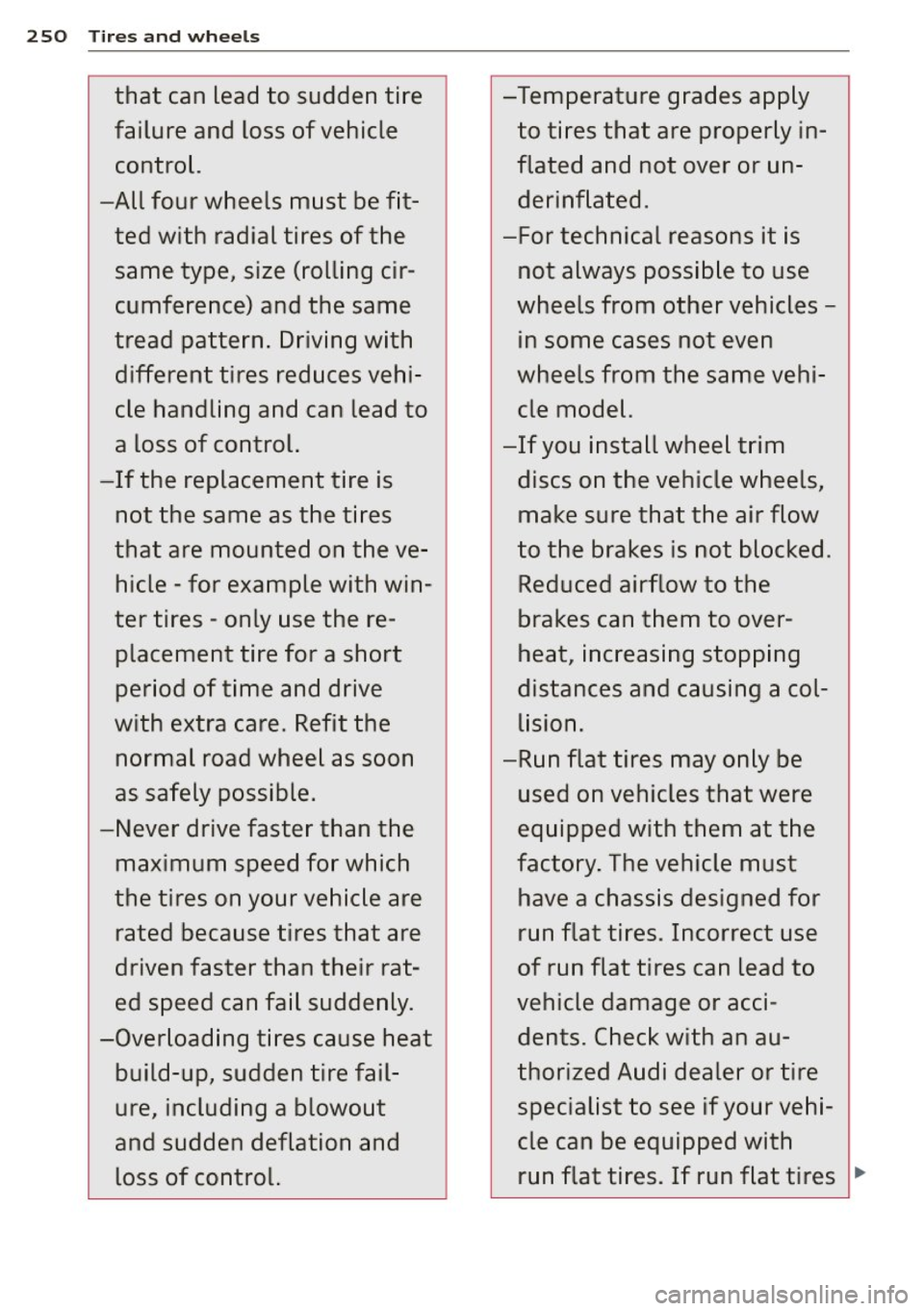
250 Tires and wheels
that can lead to sudden tire
failure and loss of vehicle
control.
-All four wheels must be fit ted with radial tires of the
same type, size (rolling cir
cumference) and the same
tread pattern. Driving with
different tires reduces vehi
cle handling and can lead to
a loss of control.
-If the replacement tire is
not the same as the tires
that are mounted on the ve hicle -for example with win
ter tires -only use the re
placement tire for a short
period of time and drive
with extra care. Refit the
normal road wheel as soon
as safely possible.
-Never drive faster than the
maximum speed for which
the tires on your vehicle are rated because tires that are
driven faster than their rat
ed speed can fail suddenly.
-Overloading tires cause heat build-up, sudden tire fail
ure, including a blowout
and sudden deflation and
loss of control. -Temperature
grades apply
to tires that are properly in
flated and not over or un derinflated .
-For technical reasons it is not always possible to use
wheels from other vehicles -
in some cases not even
wheels from the same vehi
cle model.
-If you install wheel trim
discs on the vehicle wheels,
make sure that the air flow
to the brakes is not blocked .
Reduced airflow to the
brakes can them to over
heat, increasing stopping
distances and causing a col
lision.
-Run flat tires may only be used on vehicles that were
equipped with them at the
factory. The vehicle must
have a chassis designed for
run flat tires . Incorrect use
of run flat tires can lead to
vehicle damage or acci
dents. Check with an au
thorized Audi dealer or tire
specialist to see if your vehi
cle can be equipped with
run flat tires. If run flat tires .,.
Page 254 of 302
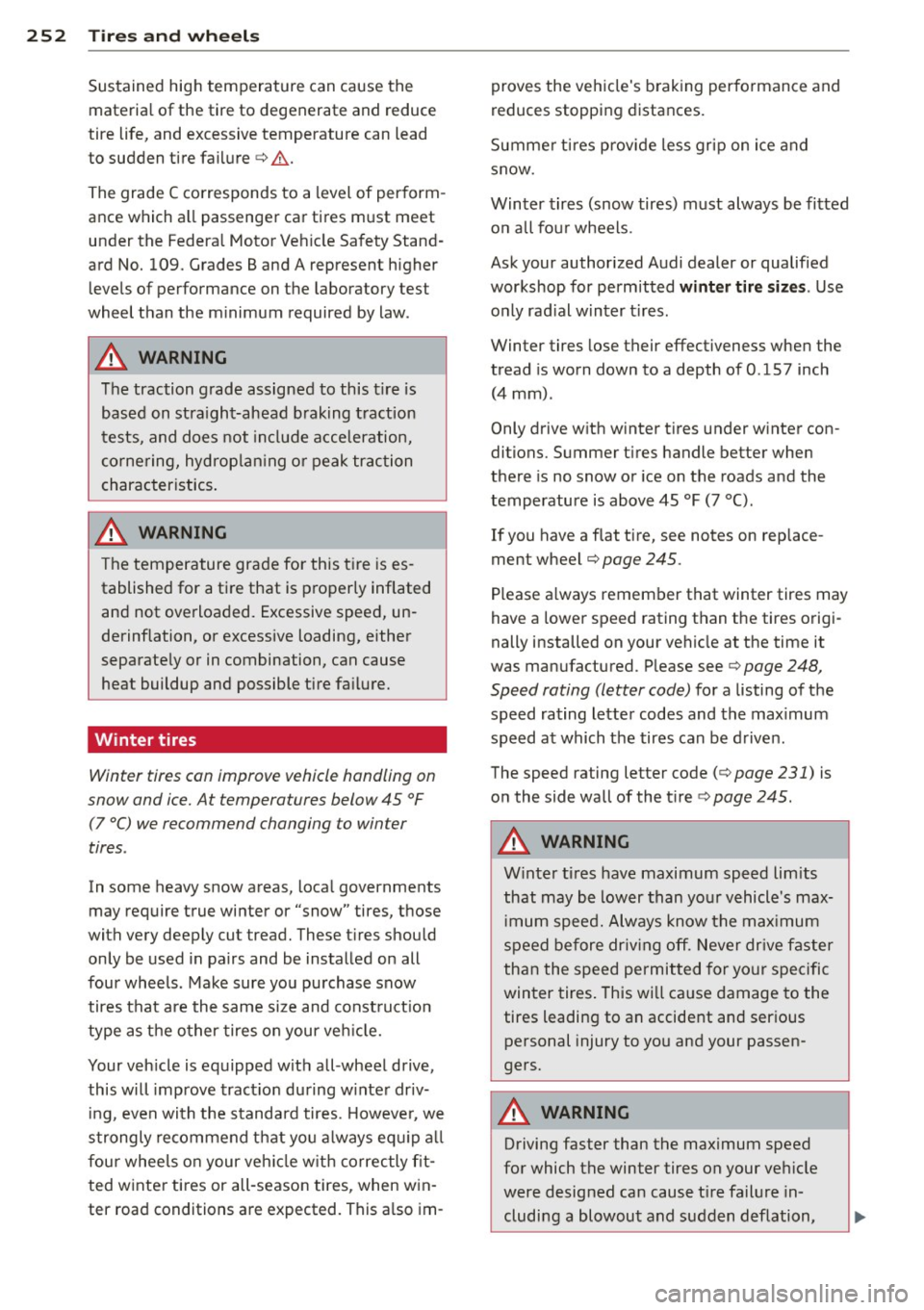
252 Tire s and wheel s
Sustained high temperature can cause the
materia l of the tire to degenerate and reduce
tire life, and excessive temperature can lead
to sudden tire failure<=>,& .
The grade C corresponds to a level of perform
ance which a ll passenger car tires must meet
under the Federa l Motor Veh icle Safety Stand
ard No.
109. Grades Band A represent higher
levels of performance on the laboratory test
wheel than the m inimum required by law .
A WARNING
The traction grade assigned to this t ire is
based on stra ight-ahead braking traction
tests, and does not include acceleration,
corne ring, hydrop lan ing o r peak traction
character istics .
A WARNING ,.,._____
The temperature grade for this tire is es
tablished for a tire that is p roperly inflated
and not overloaded. Excessive speed, un
derinflation, or excessive loading, either
separate ly or in combination, can cause
heat buildup and possible tire fa ilure.
Winter tires
Winter tires can improve vehicle handling on
snow and ice. At temperatures below 45 °F
(7 °C) we recommend changing to winter
tires .
In some heavy snow areas, loca l governments
may require true winter or "snow" tires, those
with very deeply cut tread. These t ires should
only be used in pairs and be installed on all
four wheels. Make sure yo u purchase snow
tires that are the same size and const ruct ion
type as t he other tires on your ve hicle.
Your veh icle is equipped wit h all -wheel drive,
this will improve tract ion during w inter driv
i ng, even with the standa rd tires. Howeve r, we
strongly recommend that you a lways equ ip a ll
four whee ls o n your ve hicle w ith correctly fit
ted winte r ti res or all -season tires, when win
ter road conditions are expected. This a lso im- proves the vehicle's b
raking performance and
reduces stopping distances.
Summe r tires p rovide less gr ip on ice and
snow.
Winter tires (snow tires) must always be fitted on all four wheels .
Ask your authorized Audi dealer or qualified
workshop for perm itted
winter tire si zes. Use
o n ly rad ial winter t ires .
Winter tires lose their effectiveness when the
tread is worn down to a depth of
0 .157 inch
(4 mm).
Only drive w ith w inter t ires under winter con
ditions. Summer t ires handle better when
there is no snow or ice on the roads and the
temperature is above 45 °F (7 °() .
If you have a flat tire, see notes on replace
ment wheel <=>
page 245.
Please a lways remember that winter tires may
have a lower speed rating than the tires origi
nally installed on your vehicle at the time it
was manufactured. Please see<=>
page 248,
Speed rating (letter code)
fo r a listing of the
speed rating lette r codes and the max imum
speed at which the tires can be d riven .
The speed rating letter code (<=>
page 231) is
on the side wall of the t ire
c> page 245.
A WARNING ,.___
W inter t ires have maximum speed lim its
that may be lower than yo ur vehicle's max
i mum speed. Always know the max imum
speed before dr iv ing off. Never dr ive faster
than the speed permitted for yo ur specific
winter tires . This wi ll ca use damage to the
tires leading to an accident and ser ious
personal injury to you and your passen
gers.
A WARNING
'----
Driving faster than the maximum speed
for which the winter tires on your vehicle were designed can cause t ire failure in
cluding a blowout and sudden deflation,